DMM UNI-T UT61E
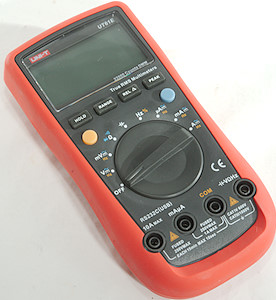
This is a old UNI-T multimeter and I have looked at it before, but I wanted to update the review to same standard as my current multimeter reviews. For the review I bought a new UT61E from China, this way I can also see if the protection in the Chinese version has been upgraded (The EU version has upgraded protection).
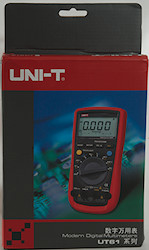

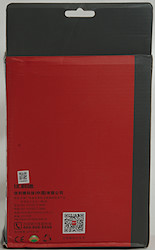

There are 5 meters in the UT61 series and the box do not show the E model or list any specifications.
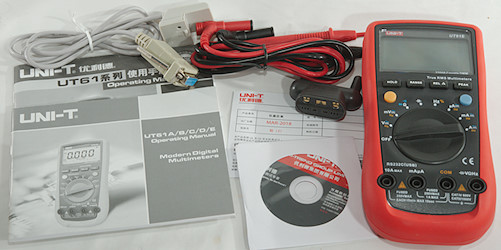
In the box was the meter, the probes, A RS232 cable, a CD with software and a manual (Both software and manual can be downloaded).


Probes are branded UNI-T and rated for 20A. They do not include tip covers, this means the CAT III & CAT IV rating is wrong.

The plugs are fully shrouded, the shroud is a bit short
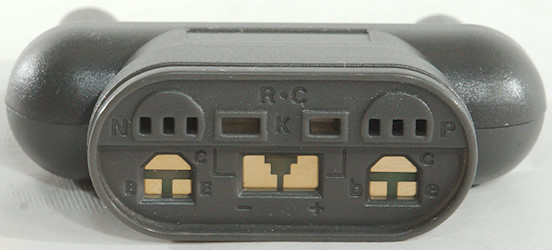

On this meter this adapter can be used when testing resistors and diodes, it uses the mAuA terminal as ground, this will add about 0.4ohm error to ohm measurements.
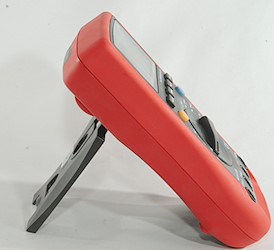
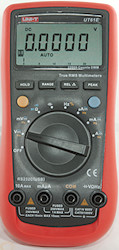
The meter is heavy enough to keep it stable while turning the range switch, this means it can easily be used with one hand, either lying flat or standing.
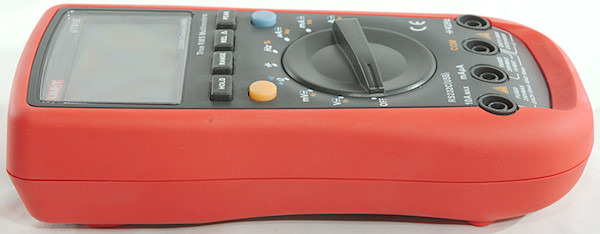
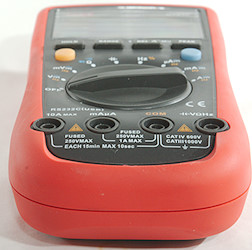
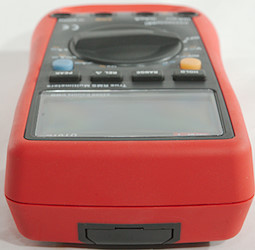

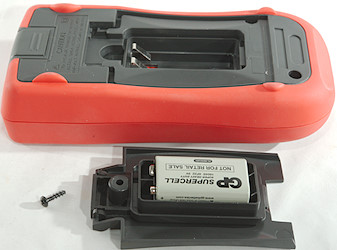
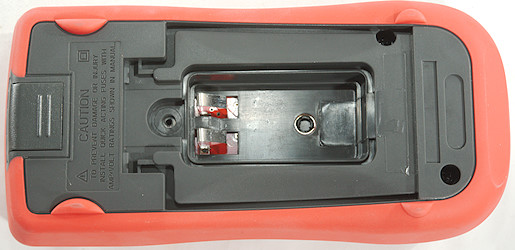
Display
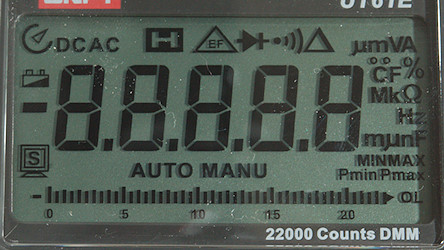
All the segments are shown during power on, not all of them are used.
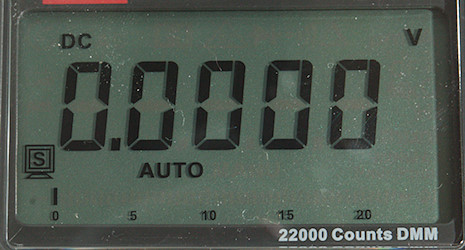
Typical display during usage, it will show the number and selected measurement. The communication marker is always on.
Functions
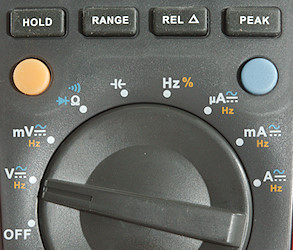
Buttons:
- Hold: Will freeze the display reading, until pressed again
- Range: Select manual range and change range, hold down to reactivate automatic ranging.
- Rel: Shows values relative to current value, will also select manual range. Press again to disable.
- Peak: Capture very fast min/max values, will also select manual range. Hold down to disable.
- (Yellow): Select frequency/duty cycle in AC voltage and current modes.
- (Blue): Select AC/DC in voltage and current mode, in ohm mode it will change between ohm/continuity/diode
Rotary switch:
- Off: Meter is turned off
- V: DC and AC voltage, use blue button to change and yellow button for frequency.
- mV: DC and AC millivolt, use blue button to change and yellow button for frequency.
 : Ohm, continuity and diode.
: Ohm, continuity and diode.
 : Capacitance.
: Capacitance.
- Hz: Logical frequency input.
- uA: Micro ampere DC or AC, use blue button to change and yellow button for frequency.
- mA: Milli ampere DC or AC, use blue button to change and yellow button for frequency.
- A: Ampere DC or AC, use blue button to change and yellow button for frequency.
Input
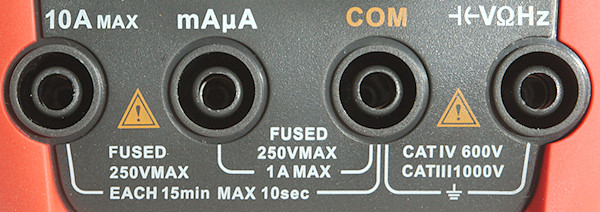
- 10ADC: 10A DC current input.
- uAmA: Micro and milliampere input.
- COM: The common terminal for all ranges.
- xxx: All other ranges.
Measurements
- Volt and frequency
- 1V AC reading is 5% up at 38kHz, rms will not work at that frequency
- Frequency input do not require a zero crossing, it can handle average from an about -4.5V to more than 8.5V with 1Vrms input.
- At 1Vrms frequency input range is from 3Hz to 78MHz
- Duty cycle works from 10% to 95% at 10kHz with 1Vpp, precision is within 1.2.
- Duty cycle works from 5% to 95% at 100kHz with 4Vpp, precision is within 0.5.
- Meter has audible alarm when V range is on overload (OL), not mV.
- Peak max/min needs about 0.1ms to capture a voltage, with very short pulses it need a few.
- Input impedance is 10-11Mohm on DC and AC
- mV DC/AC is high impedance below 3V, then drops
- Maximum voltage is 1000VDC 750VAC
- Current
- 10A range is fused with a 10A/240V 6.3x25mm fuse
- mAuA range is fused with a 1A/240V 6.3x25mm fuse
- Meter has audible alarm when range is on overload (OL)
- Ohm, continuity, diode and capacitance
- Ohm needs about 1.2s to measure 100ohm
- Ohm voltage is -0.39V open and -1.6mA shorted.
- Continuity is very fast (About 3ms).
- Continuity beeps when resistance is below 30ohm.
- Continuity is -3.0V open and -1.6mA shorted
- Diode range uses 2.9V, max. display is 1.8999V at 0.6mA, max. current is 1.9mA shorted
- 10uF takes about 0.6 second to measure.
- 70000uF takes about 13 seconds to measure.
- Overload protection is 1000VDC 750VAC
- Miscellaneous
- Current consumption of meter is between 1.5 and 4mA, typically around 2.5mA, duty cycle in voltage and current is 4mA
- Meter turns off at 1.6V, battery symbol show at 5.5V.
- Readings will be correct until meter turn off.
- Viewing angle is good
- Display updates around 2 times/sec
- Bargraph updates faster than numbers.
- Meter will not automatic turn off, due to the always enabled computer connection.
- Standard probes fits.
- The meter usual shows the correct value at second update.
- Weight is 352g without accessories, but with battery.
- Size is 180 x 88 x 44mm
- Probes
- Probe resistance 43mOhm for one.
- Probe wire are 93cm long.

Waveform while measuring 1uF
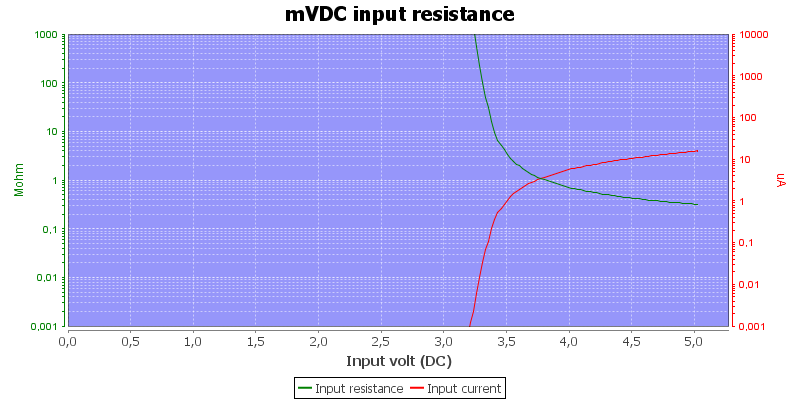
mVDC is high impedance up to about 3V.
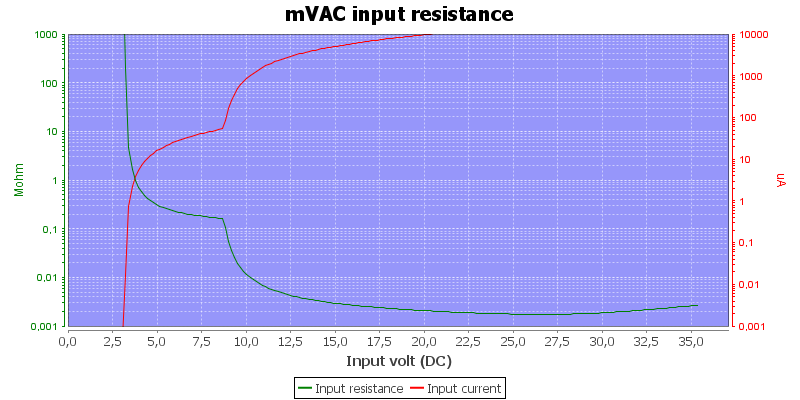
mVAC is also high impedance.

Frequency input has variable input impedance.

There is a hole in the frequency counter range, because the meter adds a extra digit.
The 220Mohm range is very sensitive to noise.
Software on PC
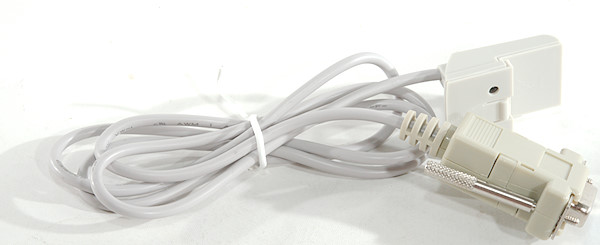
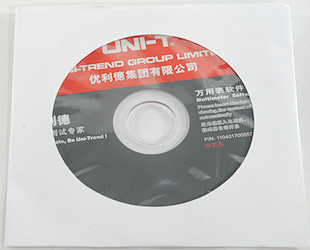
The software and RS232 cable for a computer connection is supplied. The software is on a mini CD (Can also be downloaded), it contains the software and a very basic manual for the software. The software only supports COM1 to COM4, this is very limiting.
The software is version 4.01 from 2011, CD and download is same version.
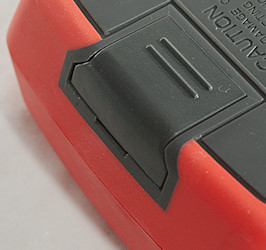
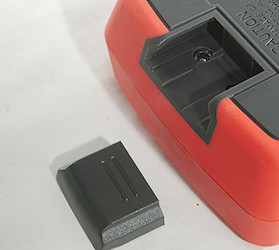

The adapter is slided in at the top of the meter.

When starting the software looks this way on a Windows 10 computer. Everything is in this view, there is no other screens (Except save and load dialogs).

Connected to the meter and receiving data, the chart do change down to a 2V scale, this is the lowest scale in voltage.
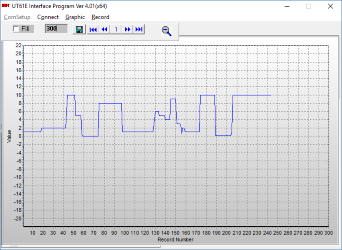
It is possible to zoom the chart to full the entire window.
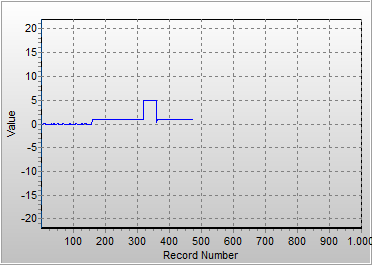
The chart can be save in BMP format, if the zoomed chart is saved it will be larger.

The software do not support peak capture mode, the meter will alternating transmit max and min captured value and the chart shows it this way. The logfile is the same way with no indication that peak mode is active.

The logfile is a TAB delimited file with a .xls or .txt extension. Excel will complain about this, but can load it correctly.

It is also possible to save the logfile in XML format, Excel can also handle this (I have removed metadata and added line break in the above image).
Tear down
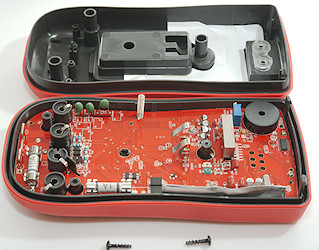
To open the meter the battery lid must be removed and two more screws.
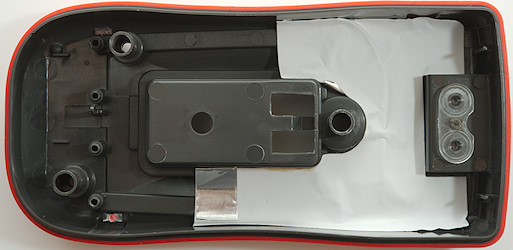
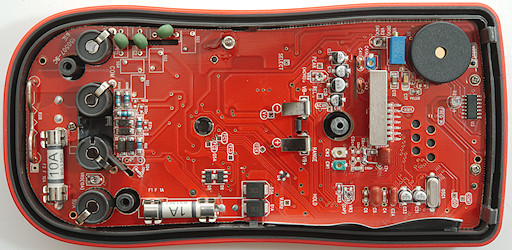
As usual the circuit board is shaped after the enclosure.
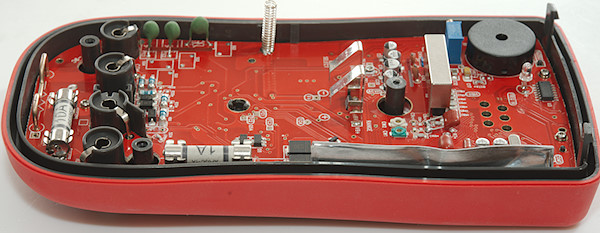
There is some shielding sticking up at the side.
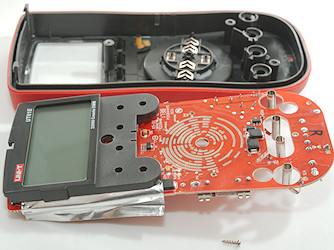
One more screw and I could take the circuit board out (Be careful to turn the screw, not some of the trimpots)
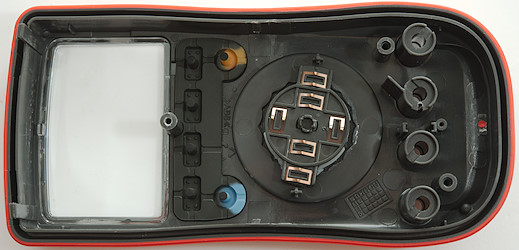
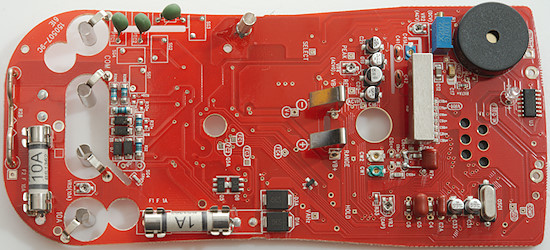
The current inputs uses 240V fuses, but it is not made the usual way. The uAmA input has 4 resistors in series (R29 (A&B), R30, R31, R32: 1ohm, 9ohm, 90ohm, 900ohm), the two first are used for mA and four are used for uA. To avoid to high voltage drop the high value resistors are bypassed by antiparallel diodes R32, D7, D8 for uA and R30, D5, D6 for mA. This circuit gives a fairly high burden voltage in some current ranges. There is also diodes directly across the uAmA input (D1, D1A, D1B, D3, D3A) this is a bridge with one diode between + and -.
The voltage input has 3 paths, each with their own PTC, but the MOV is missing. PTC3 is the voltage input and goes to a 10Mohm resistor and parallel capacitor (C41A & C41B & part of R8). Output for ohm and capacitance is through PTC1 with a transistor pair (Q1 & Q8) as protection. Input for ohm and capacitance is through PTC2 a transistor pair (Q5 & Q6), a resistors and a trimpot (R33: 100kOhm, VR3).
To drive the buzzer is a oscillator (U3: HEF4069).
There are many trimpots and trimcaps. The trimcaps are used to adjust the high frequency AC response.

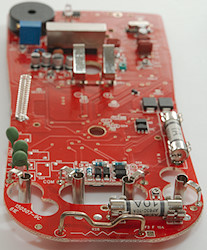


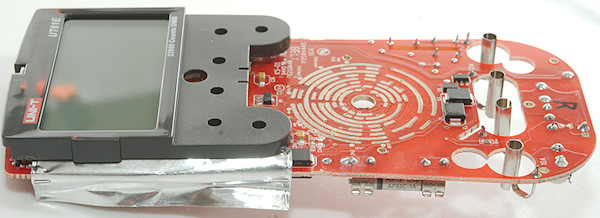
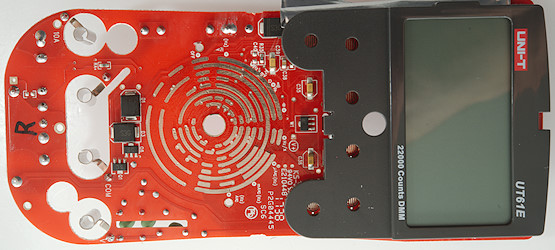
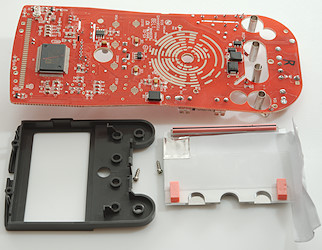
The display is mounted with two screws and a clip.
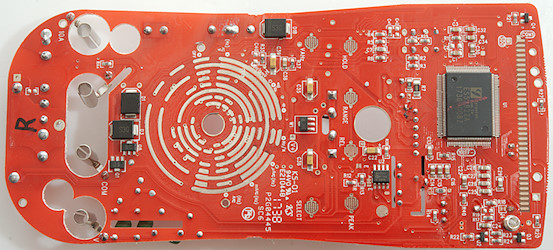
Part of the uAmA bridge rectifier is mounted on this side and also one of the transistor protection pairs.
The big chips (U1: ES51922A) is the multimeter chip and it has an RMS converter (U2: AD737J).

Conclusion
UNI-T may have correct CAT rating on some of their new meters, but this one is definitely not correct and it do have the the full protection mounted (There is space for larger fuses and MOVs).
The meter has many good features and is fast in ohm, continuity and capacitance. The weak point is current, it has a rather high burden voltage, it is also missing a min/max function.
It is a good hobby meter, except for current measurements.
Notes
UNI-T do often make rebranded meters, i.e. it may exist with other names on it.
UNI-T makes a safer EU version of this meter, it is also possible to buy a USB interface cable.
It is possible to find a schematic of the meter on the internet, but it do not match completely.
The old review The circuit board has been upgrade since then, but the software is still the same version.
How do I review a DMM
More DMM reviews
 : Ohm, continuity and diode.
: Ohm, continuity and diode.
 : Capacitance.
: Capacitance.






















 : Ohm, continuity and diode.
: Ohm, continuity and diode.
 : Capacitance.
: Capacitance.

































